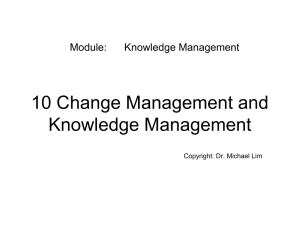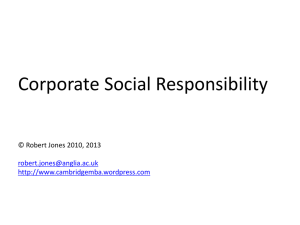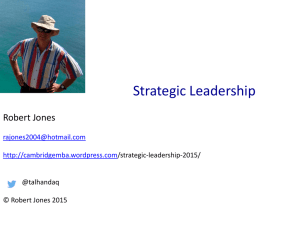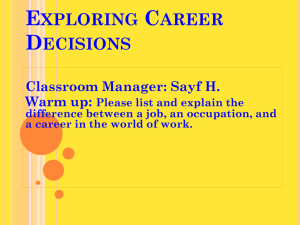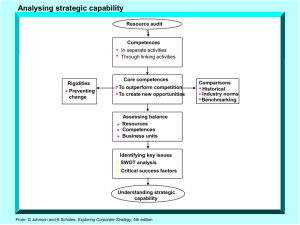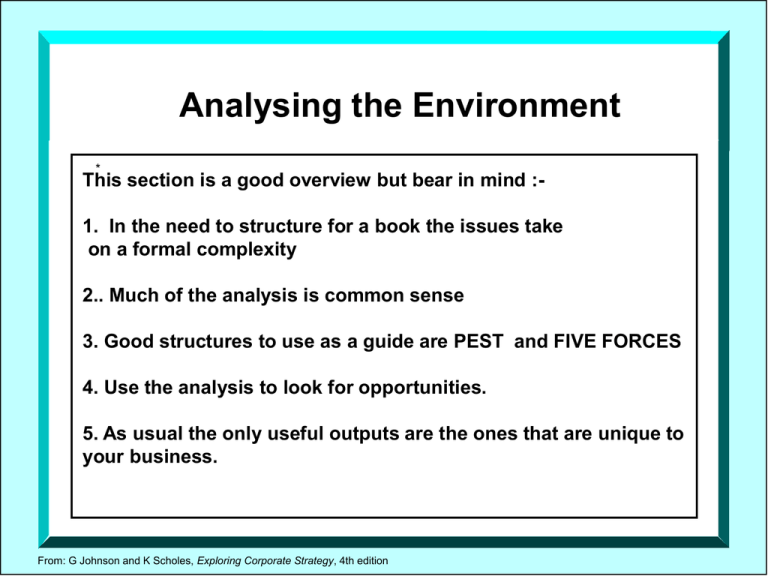
Analysing the Environment
*
This section is a good overview but bear in mind :1. In the need to structure for a book the issues take
on a formal complexity
2.. Much of the analysis is common sense
3. Good structures to use as a guide are PEST and FIVE FORCES
4. Use the analysis to look for opportunities.
5. As usual the only useful outputs are the ones that are unique to
your business.
From: G Johnson and K Scholes, Exploring Corporate Strategy, 4th edition
Steps in environmental analysis
Assess the nature of the
environment
Audit environmental
influences
Identify key
competitive forces
Identify
competitive position
Identify key
opportunities
and threats
Strategic
position
From: G Johnson and K Scholes, Exploring Corporate
Corporate Strategy,
Strategy, 4th
4th edition
edition
Figure 3.2 Approaches to making sense of the environment
Simple
ENVIRONMENTAL
CONDITIONS
Complex
Static
•Historical analysis
•Forecasting
ENVIRONMENTAL
CONDITIONS
Decentralisation
of organisations
Experience
and learning
Scenario
planning
Dynamic
From: G Johnson and K Scholes, Exploring Corporate Strategy, 4th edition
A PEST analysis of environmental influences
1. What environmental factors are affecting the opposition?
2. Which of these are the most important at the present time?
In the next few years?
Political/legal
Monopolies legislation
Environmental protection laws
Taxation policy
Foreign trade regulations
Employment law
Government stability
Economic factors
Business cycles
GNP trends
Interest rates
Money supply
Inflation
Unemployment
Disposable income
Energy availability and cost
Sociocultural factors
Population demographics
Income distribution
Social mobility
Lifestyle changes
Attitudes to work and leisure
Consumerism
Levels of education
Technological
Government spending on
research
Government and industry focus
of technical effort
New discoveries/ development
Speed of technology transfer
Rates of obsolescence
From: G Johnson and K Scholes, Exploring Corporate Strategy, 4th edition
Industry Globalisation Drivers
Illustration 3.2
Industry Globalisation Drivers
LOW
Market Convergence
X
Cost Advantages
X
Government
Influence
X
Global Competition
X
OTC Pharmaceuticals
Ethical Pharmaceuticals
Automobiles
From: G Johnson and K Scholes, Exploring Corporate Strategy, 4th edition
HIGH
X
X
X
X
X
X
X
X
Figure 3.4 Drivers of globalisation
Global market
convergence
Similar customer
needs
Global customers
Transferable
marketing
Scale economies
•Trade policies
Government
influence
•Technical standards
Global
strategies
•Host government
policies
Sourcing efficiencies
Country-specific costs
High product
development costs
Interdependence
Competitors global
High exports/
imports
Global competition
Source: Based on G. Yip, Total Global Strategy, Prentice Hall, 1995, chapter 2.
From: G Johnson and K Scholes, Exploring Corporate Strategy, 4th edition
Cost
advantages
The determinants of national advantage (Porter’s diamond)
Firm strategy,
structure and
rivalry
Demand
conditions
Factor
conditions
Related and
supporting
industries
From: G Johnson and K Scholes, Exploring Corporate Strategy, 4th edition
Five forces analysis
Potential
entrants
Threat of
entrants
Suppliers
COMPETITIVE
RIVALRY
Buyers
Bargaining
power
Bargaining
power
Threat of
substitutes
Substitutes
Source: Adapted from M. E. Porter, Competitive Strategy, Free Press, 1980, p. 4. Copyright by The
Free Press, a division of Macmillan Publishing Co., Inc. Reproduced with permission.
From: G Johnson and K Scholes, Exploring Corporate Strategy, 4th edition
Figure 3.7 The life cycle model
Development
Users/
buyers
Growth
Maturity
Few:
Growing adopters: Growing selectivity Saturation of
trial of
of purchase
trial of
users
early
product/service
Repeat purchase
adopters
reliance
Entry of
competitors
Competitive
conditions
Shakeout
Few
competitors
May be many
Attempt to
achieve trial
Fight to maintain
share
Decline
Drop-off
in usage
Exit of some
competitors
Likely price cutting
Difficulties in
Selective
for volume
gaining/taking
distribution
share
Fight for share
Shake-out of
Undifferentiated
Emphasis on
weakest
products/services competitors
efficiency/low cost
From: G Johnson and K Scholes, Exploring Corporate Strategy, 4th edition
Figure 3.8 Some characteristics for identifying strategic groups
It is useful to consider the extent to which organisations differ in terms of
characteristics such as:
Extent of product (or service) diversity
Extent of geographic coverage
Number of market segments served
Distribution channels used
Extent (number) of branding
Marketing effort (e.g. advertising spread, size of salesforce)
Extent of vertical integration
Product or service quality
Technological leadership (a leader or follower)
R&D capability (extent of innovation in product or process)
Cost position (e.g. extent of investment in cost reduction)
Utilisation of capacity
Pricing policy
Level of gearing
Ownership structure (separate company or relationship with parent)
Relationship to influence groups (e.g. government, the City)
Size of organisation
Source: Adapted from M.E. Porter, Competitive Strategy, Free Press, 1980; and J.McGee and H.Thomas,
‘Strategic groups: theory, research and taxonomy’, Strategic Management Journal, vol. 7, no. 2 (1986), pp.141-60.
From: G Johnson and K Scholes, Exploring Corporate Strategy, 4th edition
Figure 3.9 Some criteria for market segmentation
Type of factor
Consumer markets
Industrial/organisational
markets
Characteristics of
Age, sex, race
people/organisations Income
Family size
Life cycle stage
Location
Lifestyle
Industry
Location
Size
Technology
Profitability
Management
Purchase/use
situation
Size of purchase
Brand loyalty
Purpose of use
Purchasing
behaviour
Importance of
purchase
Choice criteria
Application
Importance of purchase
Volume
Frequency of purchase
Purchasing procedure
Choice criteria
Distribution channel
Users’ needs and
preferences for
product
characteristics
Product similarity
Price preference
Brand preferences
Desired features
Quality
Performance requirements
Assistance from suppliers
Brand preferences
Desired features
Quality
Service requirements
From: G Johnson and K Scholes, Exploring Corporate Strategy, 4th edition
Figure 3.10 Perceived value by customers: the luxury car market
Rating
Competitor B's car
Competitor A's car
Car X
5
4.5
4
3.5
3
2.5
2
1.5
1
0.5
0
Styling
Performance
Marque
strengths
Most important
Source: D. Faulkner and C. Bowman, The Essence of Competitive Strategy, Prentice Hall, 1995.
From: G Johnson and K Scholes, Exploring Corporate Strategy, 4th edition
Engineering
innovations
Build quality
Least important
Indicators of SBU strength and market attractiveness
Indicators of SBU strength
compared with competition
Indicators of market
attractiveness
Market share
Salesforce
Marketing
R&D
Manufacturing
Distribution
Financial resources
Managerial resources
Competitive position in terms
of, e.g. image, breadth of
product line, quality/reliability,
customer service
Market size
Market growth rate
Cyclicality
Competitive structure
Barriers to entry
Industry profitability
Technology
Inflation
Regulation
Workforce availability
Social issues
Environmental issues
Political issues
Legal issues
From: G Johnson and K Scholes, Exploring Corporate Strategy, 4th edition bbbbyh
Scenario Planning is Useful:
To take a long view of influences on strategic
choice;
Where the factors influencing the success of
strategies are:
Limited in number
Have a high impact
Uncertain
Help build plausible different futures
From: G Johnson and K Scholes, Exploring Corporate Strategy, 4th edition
Five Forces Analysis (1)
The threat of entry ...
Dependent on barriers to entry such as:
Economies of scale
Capital requirements of entry
Access to distribution channels
Cost advantages independent of size (eg the
“experience curve”)
Expected retaliation
Legislation or government action
Differentiation
From: G Johnson and K Scholes, Exploring Corporate Strategy, 4th edition
Five Forces Analysis (2)
Buyer power is likely to be high when:
There is a concentration of buyers
There are many small operators in the supplying
industry
There are alternative sources of supply
Components or materials are a high percentage
of cost to the buyer leading to “shopping around”
Switching costs are low
There is a threat of backward integration
From: G Johnson and K Scholes, Exploring Corporate Strategy, 4th edition
Five Forces Analysis (3)
Supplier power is high when:
There is a concentration of suppliers
Switching costs are high
The supplier brand is powerful
Integration forward by the supplier is possible
Customers are fragmented and bargaining power
low
From: G Johnson and K Scholes, Exploring Corporate Strategy, 4th edition
Five Forces Analysis (4)
Threat of substitutes
Substitutes take different forms:
Product substitution
Substitution of need
Generic substitution
Doing without
From: G Johnson and K Scholes, Exploring Corporate Strategy, 4th edition
Five Forces Analysis (5)
Competitive Rivalry is high when:
Entry is likely
Substitutes threaten
Buyers or suppliers exercise control
Competitors are in balance
There is slow market growth
Global customers increase competition
There are high fixed costs in an industry
Markets are undifferentiated
There are high exit barriers
From: G Johnson and K Scholes, Exploring Corporate Strategy, 4th edition
Five Forces Analysis: Key Questions and
Implications
What are the key forces at work in the
competitive environment?
Are there underlying forces driving competitive
forces?
Will competitive forces change?
What are the strengths and weaknesses of
competitors in relation to the competitive forces?
Can competitive strategy influence competitive
forces (eg by building barriers to entry or
reducing competitive rivalry)?
From: G Johnson and K Scholes, Exploring Corporate Strategy, 4th edition
Strategic Group Analysis
Strategic Group Analysis is useful to:
Identify firms with similar strategic characteristics
Therefore identify the most direct competitors
Identify mobility barriers
Identify strategic opportunities (“strategic
spaces”)
Strategic threats and problems
From: G Johnson and K Scholes, Exploring Corporate Strategy, 4th edition

